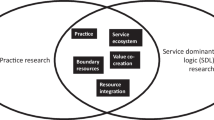Overview
- Authors:
-
-
Jeanette Blomberg
-
IBM Almaden Research Center, USA
-
Chuck Darrah
-
San Jose State University, USA
Access this book
Other ways to access
About this book
This book explores the possibility for an anthropology of services and outlines a practice approach to designing services. The reader is taken on a journey that Blomberg and Darrah have been on for the better part of a decade from their respective positions helping to establish a services research group within a large global enterprise and an applied anthropology master's program at a Silicon Valley university. They delve into the world of services to understand both how services are being conceptualized today and the possible benefits that might result from taking an anthropological view on services and their design. The authors argue that the anthropological gaze can be useful precisely because it combines attention to details of everyday life with consideration of the larger milieu in which those details make sense. Furthermore, it asks us to reflect upon and assess our own perspectives on that which we hope to understand and change. Central to their exploration is the question of how to conceptualize and engage with the world of services given their heterogeneity, the increasing global importance of the service economy, and the possibilities introduced for an engaged scholarship on service design. While discourse on services and service design can imply something distinctively new, the authors point to parallels with what is known about how humans have engaged with each other and the material world over millennia. Establishing the ubiquity of services as a starting point, the authors go on to consider the limits of design when the boundaries and connections between what can be designed and what can only be performed are complex and deeply mediated. In this regard the authors outline a practice approach to designing that acknowledges that designing involves participating in a social context, that design and use occur in concert, that people populate a world that has been largely built by and with others, and that formal models of services are impoverished representations of human performance. An Anthropology of Services draws attention to the conceptual and methodological messiness of service worlds while providing the reader with strategies for intervening in these worlds for human betterment as complex and challenging as that may be. Table of Contents: Preface / Acknowledgments / Getting Started / From Services to Service Worlds / The Human Condition / Service Concepts / Design and its Limits / Service Design / An anthropology of Services / References / Author Biographies
Similar content being viewed by others
Article
Open access
19 August 2023
Table of contents (7 chapters)
-
Front Matter
Pages i-xvii
-
- Jeanette Blomberg, Chuck Darrah
Pages 1-10
-
- Jeanette Blomberg, Chuck Darrah
Pages 11-21
-
- Jeanette Blomberg, Chuck Darrah
Pages 23-31
-
- Jeanette Blomberg, Chuck Darrah
Pages 33-44
-
- Jeanette Blomberg, Chuck Darrah
Pages 45-53
-
- Jeanette Blomberg, Chuck Darrah
Pages 55-71
-
- Jeanette Blomberg, Chuck Darrah
Pages 73-80
-
Authors and Affiliations
-
IBM Almaden Research Center, USA
Jeanette Blomberg
-
San Jose State University, USA
Chuck Darrah
About the authors
Jeanette Blomberg is an anthropologist who has worked in high tech, corporate research contexts for over three decades - first at the Xerox Palo Alto Research Center (PARC), later at Sapient Corporation, and currently at IBM Research. Along the way she has been an industry-affiliated professor at the Blekinge Institute of Technology in Sweden where she received an honorary doctorate in 2011. Her research includes a critical assessment of the promise of data analytics within the context of the enterprise, designing ethnographically informed organizational interventions, and participatory design.Chuck Darrah is professor and chair of the Department of Anthropology at San Jose State University. His research focuses on work, workplaces, families, and technology. He co-founded the Silicon Valley Cultures Project and later the Human Aspiration and Design Laboratory (HADLab), both at San Jose State University.




